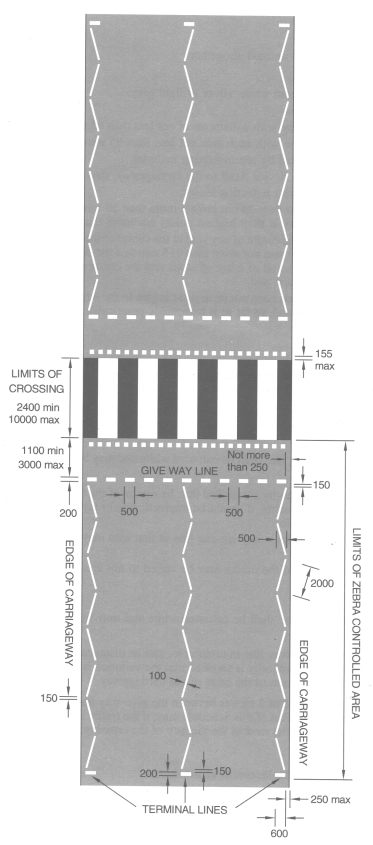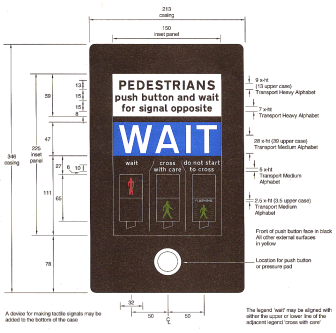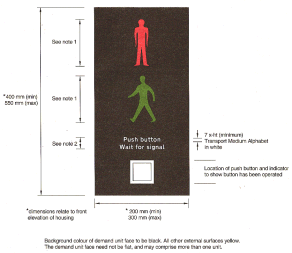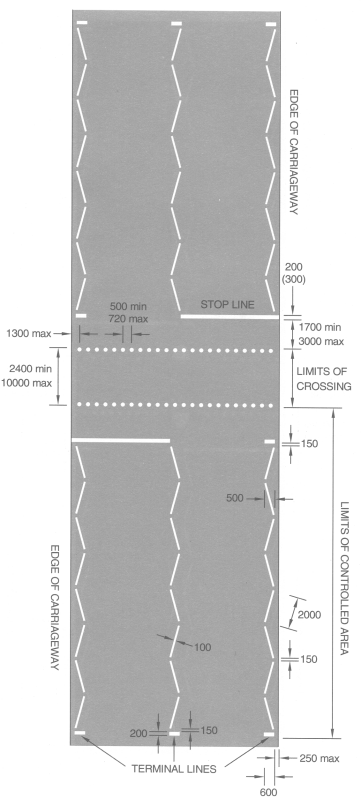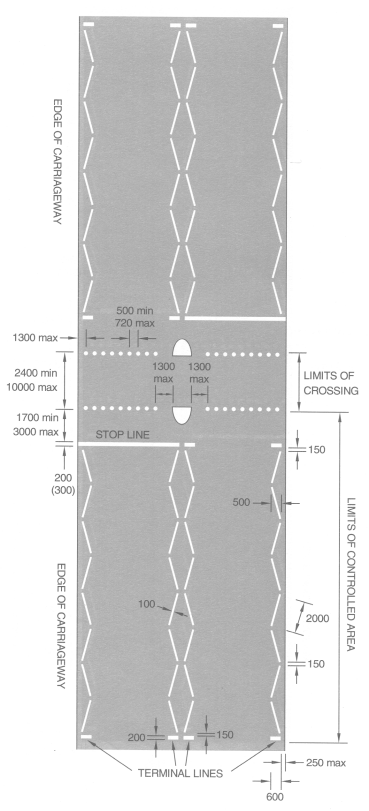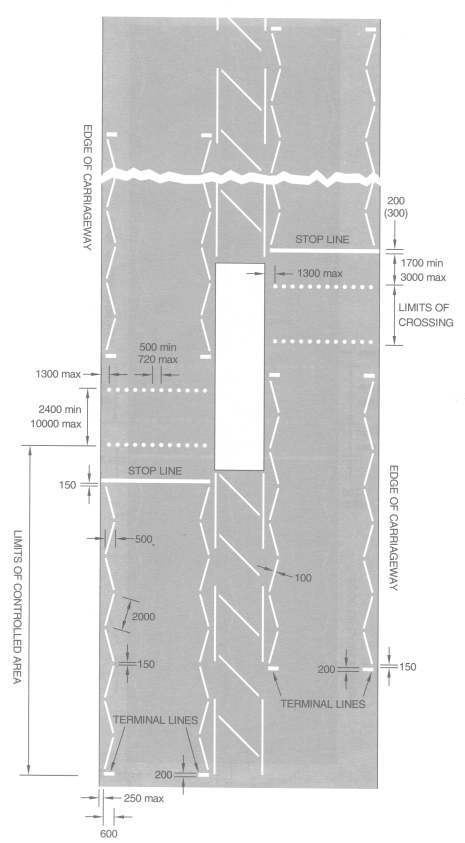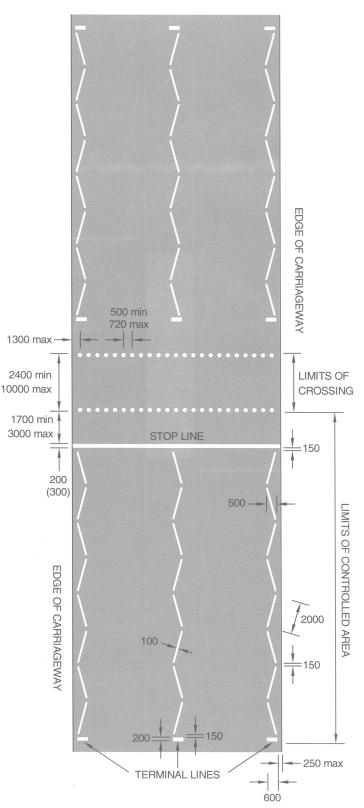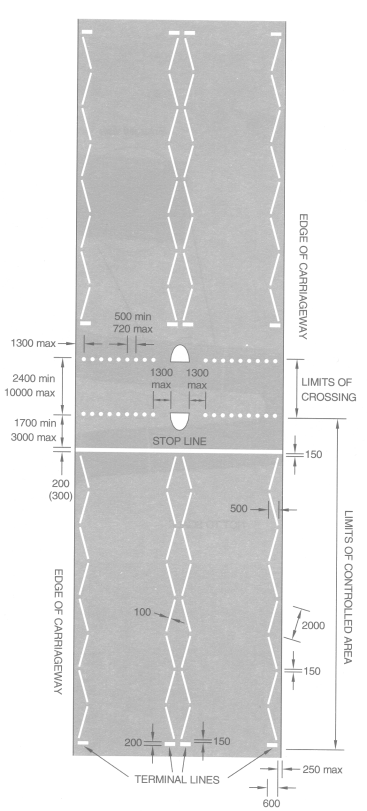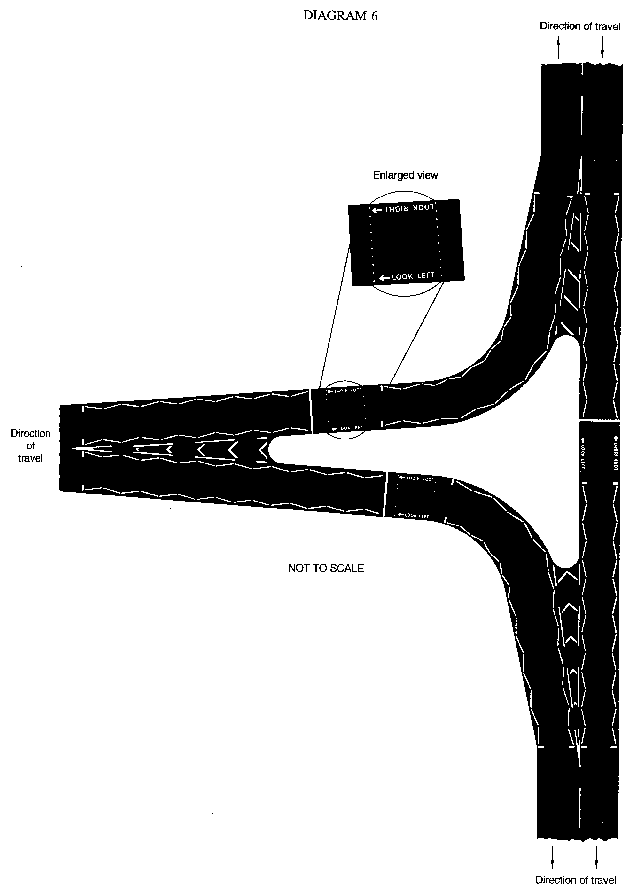- Y Diweddaraf sydd Ar Gael (Diwygiedig)
- Gwreiddiol (a wnaed Fel)
The Zebra, Pelican and Puffin Pedestrian Crossings Regulations and General Directions 1997
You are here:
- Offerynnau Statudol y Deyrnas Unedig
- 1997 No. 2400
- Schedules only
Rhagor o Adnoddau
Status:
Dyma’r fersiwn wreiddiol (fel y’i gwnaed yn wreiddiol).
Regulations 5(1) and 6(1)
SCHEDULE 1TRAFFIC SIGNS AND ROAD MARKINGS TO INDICATE ZEBRA CROSSINGS AND ZEBRA CONTROLLED AREAS
PART ITRAFFIC SIGNS
1.—(1) Subject to the following provisions of this Part of this Schedule the traffic signs which are to be placed at or near a Zebra crossing for the purpose of indicating it shall consist of globes each of which is—
(a)coloured yellow or fluorescent yellow;
(b)not less than 275 nor more than 335 mm in diameter;
(c)illuminated by a flashing light or, where the Secretary of State so authorises in writing in relation to a particular crossing a constant steady light; and
(d)mounted on a post or bracket so that the lowest part of a globe is not less than 2.1 metres nor more than 3.1 metres above the surface of the ground immediately beneath it.
(2) One globe shall be placed at each end of the crossing and, if there is a refuge for pedestrians or central reservation on the crossing, one or more globes may, if the traffic authority thinks fit, be placed on the refuge or central reservation.
2. Where a globe is mounted on or attached to a post, whether or not specially provided for the purpose—
(a)the post shall be coloured in alternate black and white bands, the lowest band being coloured black;
(b)the bands shall be not less than 275 mm nor more than 335 mm wide except that the lowest band may be up to 1 metre wide; and
(c)the post may be internally illuminated.
3. A globe or the post on which it is mounted may be fitted with all or any of the following—
(a)a backing board or other device designed to improve the conspicuousness of the globe;
(b)a shield or other device designed to prevent or reduce light shining into adjacent premises;
(c)a light to illuminate the crossing.
4. A crossing shall not be taken to have ceased to be indicated in accordance with this Part of this Schedule by reason only of—
(a)the imperfection, disfigurement or discolouration of any globe or post, or
(b)the failure of illumination of any of the globes.
5. Nothing in this Part of this Schedule shall be taken to restrict regulation 8 or 9.
PART IIROAD MARKINGS
Road markings
6. Subject to the following provisions of this Part of this Schedule—
(a)within the limits of a Zebra crossing the carriageway shall be marked with a series of alternate black and white stripes;
(b)the Zebra controlled areas shall be marked with give-way lines, a line of studs and zig-zag lines,
of the size and type, and generally in the manner, shown in the diagram at the end of this Part of this Schedule.
Number of studs and stripes
7. The number of studs and stripes may be varied.
Limits of the crossing
8.—(1) If it provides a reasonable contrast with the white stripes, the colour of the surface of the carriageway may be used to indicate the stripes shown coloured black in the diagram.
(2) The white stripes may be illuminated by retroreflecting material.
(3) Subject to paragraph (4) each black and each white stripe shall be of the same size and not less than 500 mm nor more than 715 mm wide as measured across the carriageway.
(4) The first stripe at each end may be up to 1300 mm wide and, if the traffic authority consider it appropriate in relation to a particular crossing having regard to the layout of the carriageway or other special circumstances, the other stripes may be not less than 380 mm nor more than 840 mm wide as measured across the carriageway.
Studs
9.—(1) The studs may be omitted altogether.
(2) If studs are provided—
(a)they shall be coloured white, silver or light grey;
(b)they shall be either—
(i)circular in shape with a diameter of not less than 95 mm nor more than 110 mm; or
(ii)square in shape with each side not less than 95 mm nor more than 110 mm long;
(c)they may illuminated by retroreflecting material;
(d)if they consist of a device fixed to the carriageway, they shall—
(i)not be fitted with reflecting lenses;
(ii)be so fixed that they do not project more than 20 mm above the adjacent surface of the carriageway at their highest points nor more than 6 mm at their edges;
(e)the distance from the centre of any stud to the centre of the next stud in the same line shall not be less than 250 mm nor more than 715 mm and the distance between the edge of the carriageway at each end of a line of studs and the centre of the nearest stud shall be not more than 1.3 metres; and
(f)the two lines of studs need not be at right angles to the edge of the carriageway, but shall form straight lines and, so far as is reasonably practicable, shall be parallel to each other.
Zig-zag lines
10.—(1) The pattern of the central zig-zag lines may be reversed or, on a road having a carriageway not more than 6 metres wide, those lines may be omitted altogether so long as they are replaced by the road marking shown in diagram 1004 in Schedule 6 to the 1994 Regulations.
(2) Subject to sub-paragraph (4) the number of marks in a zig-zag line shall not be less than 8 nor more than 18 and a zig-zag line need not contain the same number of marks as any other zig-zag line.
(3) Each mark in a zig-zag line shall be coloured white and may be illuminated by retroreflecting material.
(4) Where the traffic authority is satisfied that, by reason of the layout or character of any roads in the vicinity of a Zebra crossing, it would be impracticable to lay out a Zebra controlled area in accordance with this Schedule—
(a)the number of marks in any zig-zag line in that area may be reduced to not less than 2; and
(b)the length of any of the marks may be varied to not less than 1 metre.
Give-way line
11.—(1) The give-way line shall be coloured white and may be illuminated by retroreflecting material.
(2) The angle of the give-way line in relation to, and its distance from, the edge of the crossing may be varied, if the traffic authority is satisfied that the variation is necessary having regard to the angle of the crossing in relation to the edge of the carriageway.
(3) The maximum distance of 3 metres between the give-way line and the limits of the crossing shown in the diagram in this Part of this Schedule may, if the traffic authority think fit having regard to the layout or character of the road in the vicinity of the crossing, be increased to not more than 10 metres.
Discolouration or partial displacement of markings
12. A Zebra crossing or a Zebra controlled area shall not be deemed to have ceased to be indicated in accordance with this Schedule by reason only of the discolouration or partial displacement of any of the road markings prescribed by this Schedule, so long as the general appearance of the pattern of the lines is not impaired.
PART IIDIAGRAM
Regulation 5(2)(a)
SCHEDULE 2TRAFFIC SIGNS TO INDICATE PELICAN CROSSINGS
PART ITRAFFIC SIGNS TO BE PLACED AT OR NEAR PELICAN CROSSINGS
Interpretation
1. In this Schedule “push button” has the meaning given by paragraph 5(c).
Traffic signs
2. The traffic signs which are to be placed at or near a Pelican crossing shall consist of a combination of—
(a)vehicular light signals;
(b)pedestrian light signals; and
(c)indicators for pedestrians,
of the size, colour and type specified in the following provisions of this Part of this Schedule, together with any additional traffic signs placed in accordance with regulation 9.
Vehicular light signals
3.—(1) The vehicular light signals shall be of the size, colour and type of the signals shown in diagram 3000 in Schedule 8 to the 1994 Regulations, except that a green arrow may be substituted for the green aspect in the manner shown in diagram 3003 in that Schedule or in accordance with any variant permitted by those Regulations in respect of that diagram.
(2) The lamp showing an amber light shall be capable of showing a light which is either steady or which flashes at a rate of not less than 70 nor more than 90 flashes per minute.
(3) The vehicular light signals shall be illuminated in the following sequence—
(a)steady green,
(b)steady amber,
(c)steady red,
(d)flashing amber.
Pedestrian light signals
4.—(1) The pedestrian light signals shall be of the size, colour and type of the signals shown in diagram 4002 in Schedule 9 to the 1994 Regulations.
(2) The signals shall be so designed that—
(a)they operate in the following sequence—
(i)steady red,
(ii)steady green,
(iii)flashing green;
(b)the red figure can be internally illuminated by a steady light;
(c)the green figure can be internally illuminated by a steady light or a light which flashes at a rate of not less than 70 nor more than 90 flashes per minute; and
(d)when one signal is illuminated the other is not.
(3) The signals may incorporate a device for emitting audible signals whilst the green figure is illuminated by a steady light.
Indicators for pedestrians
5. The indicators for pedestrians—
(a)shall be of the size, colour and type shown in the diagram in Part II of this Schedule;
(b)shall be so constructed that the word “WAIT” as shown on the diagram can be illuminated;
(c)shall incorporate a push button or other switching device (referred to in this Schedule as a “push button”) which can be used by pedestrians with the effect described in paragraphs 6 and 7;
(d)shall be so constructed that the instruction for pedestrians shown in the diagram can be internally illuminated; and
(e)may be so constructed that a device giving audible or tactile signals is provided for use when the green figure shown in the diagram is illuminated by a steady light.
Co-ordination of light signals and indicators for pedestrians
6.—(1) The vehicular light signals, pedestrian light signals and the indicators for pedestrians shall be so constructed that—
(a)before the signals and indicators are operated by the pressing of a push button (or by remote control in accordance with paragraph 7)—
(i)the vehicular light signals show a green or red light,
(ii)the pedestrian light signals show a red light,
(iii)the word “WAIT” on the indicators for pedestrians is not illuminated,
(iv)any device for giving tactile signals is inactive; and
(v)any device for giving audible signals is silent;
(b)when a push button is pressed or the signals and indicators are operated by remote control—
(i)the signals and indicators show lights in the sequences specified in descending order in—
(a)column (1) in the case of vehicular light signals;
(b)in column (2) in the case of pedestrian light signals; and
(c)in column (3) in the case of indicators for pedestrians,
of either Part III or Part IV of this Schedule;
(ii)when the pedestrian light signals are showing a steady green light, the word “WAIT” in the indicators for pedestrians is not illuminated;
(iii)when the pedestrian light signals are showing a flashing green light, the word “WAIT”in the indicators for pedestrians is illuminated immediately and the signals and indicators are caused to show lights in the sequence specified in paragraph (i) above at the end of the next vehicle period; and
(iv)when the pedestrian light signals are showing a red light, the word “WAIT” in the indicators for pedestrians is illuminated immediately and the vehicular light signals and indicators for pedestrians are caused to show lights in the sequence specified in paragraph (i);
(c)the periods during which lights are shown by the signals and indicators, begin and end in relation to each other as shown in either Part III or Part IV of this Schedule as if each horizontal line in those Parts represented one moment of time, subsequent moments occurring in descending order, but the distances between the horizontal lines do not represent the lengths of the periods during which lights shown by the signals and indicator are, or are not, lit.
(2) Where a device for emitting audible signals is provided pursuant to paragraph 4(3) or (5)(e), it shall be so constructed that the device operates only when the pedestrian light signals are showing a steady green light and at the same time the vehicular light signals are showing a red light.
(3) Where a device for giving tactile signals is provided pursuant to paragraph 5(e), it shall be so constructed that, when it is operating, a regular movement perceptible to touch by pedestrians is made only when the pedestrian light signals are showing a steady green light and at the same time the vehicular light signals are showing a red light.
(4) In this paragraph “vehicle period” means such period as may be fixed from time to time in relation to a Pelican crossing, being a period which begins when the vehicular light signals cease to show a flashing amber light and during which those signals show a green light.
Operation by remote control
7. The vehicular light signals, pedestrian light signals, indicators for pedestrians and any device for giving tactile signals or emitting audible signals, when they are placed at or near a Pelican crossing may also be so constructed that they can be operated by remote control.
PART IIINDICATOR FOR PEDESTRIANS
PART IIISEQUENCE OF OPERATION OF VEHICULAR AND PEDESTRIAN LIGHT SIGNALS AND INDICATOR FOR PEDESTRIANS (BUT NOT THE AUDIBLE OR TACTILE SIGNALS)
| Sequence of vehicular traffic light signals | Sequence of pedestrian signals | |
|---|---|---|
| Pedestrian light signals | Indicator for pedestrians | |
| (1) | (2) | (3) |
| Green light | Red light | The word “WAIT” is illuminated |
| Amber light | ||
| Red light | ||
| Green light | The word “WAIT” is not illuminated | |
| Flashing amber light | Flashing green light | The word “WAIT” is illuminated |
| Red light | ||
| Green light | ||
PART IVALTERNATIVE SEQUENCE OF OPERATION OF VEHICULAR AND PEDES TRIAN LIGHT SIGNALS AND INDICATOR FOR PEDESTRIANS (BUT NOT THE AUDIBLE OR TACTILE SIGNALS)
| Sequence of vehicular traffic light signals | Sequence of pedestrian signals | |
|---|---|---|
| Pedestrian light signals | Indicator for pedestrians | |
| (1) | (2) | (3) |
| Green light | Red light | The word “WAIT” is illuminated |
| Amber light | ||
| Red light | ||
| Green light | The word “WAIT” is not illuminated | |
| Flashing amber light | Flashing green light | The word “WAIT” is illuminated |
| Red light | ||
| Green light | ||
Regulation 5(3)(a)
SCHEDULE 3
PART ITRAFFIC SIGNS TO INDICATE PUFFIN CROSSINGS
Traffic signs at or near a Puffin crossing
1. The traffic signs which are to be placed at or near a Puffin crossing by virtue of regulation 5(3)(a) shall consist of a combination of—
(a)vehicular light signals; and
(b)pedestrian demand units,
of the size, colour and type specified in the following provisions of this Schedule, together with any additional traffic signs placed in accordance with regulation 9.
Vehicular light signals
2.—(1) The vehicular light signals shall be of the size, colour and type shown in diagram 3000 in Schedule 8 to the 1994 Regulations, except that a green arrow may be substituted for the green aspect in the manner shown in diagram 3003 in that Schedule or in accordance with any variant permitted by those Regulations in respect of that diagram.
(2) The vehicular lights shall be illuminated in the following sequence—
(a)red,
(b)red and amber together,
(c)green,
(d)amber.
Pedestrian demand unit
3.—(1) A pedestrian demand unit shall be placed at each end of a crossing.
(2) Each such unit shall consist of a device the principal features of which are a signal display of the size, colour and type shown in the diagram in Part II of this Schedule and which—
(a)complies with the requirements of sub-paragraph (3); and
(b)includes a push button or other switching device which in some way indicates to pedestrians that it has been operated.
(3) The requirements referred to in sub-paragraph (2)(a) are—
(a)the signal display must comprise a red figure and a green figure, both of which can be internally illuminated;
(b)while one figure is illuminated the other figure must not be capable of being illuminated; and
(c)the green figure must be capable of being illuminated only whilst there is conveyed to vehicular traffic, by means of the red vehicular light signal prescribed by paragraph 2, a prohibition against entering the limits of the Puffin crossing at or near which the unit is displayed and at no other time.
(4) The pedestrian demand unit may incorporate a device for emitting tactile or audible signals whilst the green figure is illuminated.
(5) Units consisting of only the red and green figures or the push button and legend comprised in a pedestrian demand unit may be provided at a crossing in addition to pedestrian demand units.
PART IIPEDESTRIAN DEMAND UNIT
| Note 1 | The figures shall be each 100 mm high (minimum) and of the colour and type shown in diagram 4002 in the 1994 Regulations The direction of the GREEN figure may be reversed. More than one RED and GREEN figure may be provided. |
| Note 2 | The legend may be varied to
or another legend approved by the Secretary of State. |
Regulation 5(2)(b) and (3)(b) and 6(2) and (3)
SCHEDULE 4
PART IROAD MARKINGS TO INDICATE PELICAN AND PUFFIN CROSSINGS, PELICAN AND PUFFIN CONTROLLED AREAS AND STOP LINES
Interpretation of Schedule
1. In this Schedule, except where otherwise stated,—
(a)a reference to a “crossing” is to a Pelican crossing or a Puffin crossing;
(b)a reference to a “controlled area” is to a Pelican controlled area or a Puffin controlled area;
(c)a reference to a numbered diagram is a reference to the diagram in Part II of this Schedule so numbered.
Indication of limits of crossings and of controlled areas and stop lines
2.—(1) Subject to the provisions of this Schedule, the limits of a crossing on a two-way street and of its controlled areas and stop lines shall be indicated by road markings consisting of lines and studs on the carriageway of the size and type shown—
(a)in diagram 1 where there is no central reservation;
(b)in diagram 2 where there is a central reservation, but the crossing does not form part of a system of staggered crossings; and
(c)in diagram 3 where the crossing forms part of a system of staggered crossings.
(2) Subject to the provisions of this Schedule, the limits of a crossing on a one-way street and of its controlled areas and stop lines shall be indicated by road markings consisting of lines and studs placed on the carriageway of the size and type shown—
(a)in diagram 4 where there is no central reservation;
(b)in diagram 5 where there is a central reservation but the crossing does not form part of a system of staggered crossings; and
(c)in diagram 6 where the crossing forms part of a system of staggered crossings.
(3) The two lines of studs indicating the limits of a crossing need not be at right angles to the edge of the carriageway, but shall form straight lines and shall, as near as is reasonably practicable, be parallel to each other.
Controlled areas and stop lines on a two-way street
3.—(1) Where a crossing is on a two-way street the road markings to indicate each controlled area and stop line shall consist of—
(a)a stop line parallel to the nearer row of studs indicating the limits of the crossing and extending, in the manner indicated in the appropriate diagram, across the part of the carriageway used by vehicles approaching the crossing from the side on which the stop line is placed; and
(b)two or more longitudinal zig-zag lines or, in the case of a road having more than one carriageway, two or more such lines on each carriageway, each zig-zag line containing not less than 8 nor more than 18 marks and extending away from the crossing.
(2) Subject to paragraph (3), where a central reservation is provided, the road marking shown in diagram 1040 in Schedule 6 to the 1994 Regulations may be placed between the zig-zag lines on the approaches to the central reservation.
(3) Where a central reservation is provided connecting crossings which form part of a system of staggered crossings, the road marking shown in diagram 1040.2 in Schedule 6 to the 1994 Regulations shall be placed in the manner indicated in diagram 3.
(4) The distance between the studs and the terminal marks on the exit sides shall be not less than 1700 mm nor more than 3000 mm.
Controlled areas and stop line on a one-way street
4.—(1) Where a crossing is on a one-way street the road markings to indicate a controlled area and stop line shall consist of—
(a)a stop line parallel to the nearer row of studs indicating the limits of the crossing and extending—
(i)in the case of a crossing of the type shown in diagram 4 or 5, from one edge of the carriageway to the other; and
(ii)in the case of a crossing of the type shown in diagram 6, from the edge of the carriageway to the central reservation; and
(b)two or more zig-zag lines, each containing not less than 8 nor more than 18 marks and extending away from the crossing.
(2) Subject to paragraph (3), where a central reservation is provided, the road marking shown in diagram 1041 in Schedule 6 to the 1994 Regulations may be placed between the zig-zag lines on the approaches to the central reservation.
(3) Where a central reservation is provided connecting crossings which form part of a system of staggered crossings, the road marking mentioned in paragraph (2) shall be placed in the manner indicated in diagram 6.
Variations in relation to a controlled area or stop line
5.—(1) Where the traffic authority is satisfied that, by reason of the layout or character of the roads in the vicinity of a crossing, it is impracticable to indicate a controlled area in accordance with the requirements of the preceding provisions of this Schedule, the following variations shall be permitted—
(a)the number of marks in each zig-zag line may be reduced to not less than 2;
(b)the marks comprised in a zig-zag line may be varied to a length of not less than 1 metre, in which case—
(i)each mark in each zig-zag line must be of the same or substantially the same length as the other marks in the same line;
(ii)and the number of marks in each line must be not more than 8 nor less than 2.
(2) The angle of a stop line in relation to the nearer line of studs indicating the limits of a crossing may be varied, if the traffic authority is satisfied that the variation is necessary having regard to the angle of the crossing in relation to the edge of the carriageway.
(3) The maximum distance of 3 metres between a stop line and the nearer line of studs indicating the limits of the crossing shown in the diagrams in this Schedule may be increased to such greater distance, not exceeding 10 metres, as the traffic authority may decide.
(4) Each zig-zag line in a controlled area need not contain the same number of marks as the others and the pattern of the central lines may be reversed or, if the carriageway is not more than 6 metres wide, may be omitted altogether if replaced by the road marking shown in diagram 1004 in Schedule 6 to the 1994 Regulations.
Colour and illumination of road markings
6. Subject to paragraph 7, the road markings shown in the diagrams in this Schedule shall be coloured white and may be illuminated by retroreflecting material.
Form and colour of studs
7.—(1) The studs shown in the diagrams in this Schedule shall be—
(a)coloured white, silver or light grey and shall not be fitted with reflective lenses; and
(b)either circular in shape with a diameter of not less than 95 mm nor more than 110 mm or square in shape with the length of each side being not less than 95 mm nor more than 110 mm.
(2) Any stud which is fixed or embedded in the carriageway shall not project more than 20 mm above the carriageway at its highest point nor more than 6 mm at its edges.
Supplementary
8. The requirements of this Schedule shall be regarded as having been complied with in the case of any crossing or controlled area, if most of the road markings comply with those requirements, even though some of the studs or lines do not so comply by reason of discolouration, temporary removal or a displacement or for some other reason, so long as the general appearance of the road markings as a whole is not thereby materially impaired.
PART IIDIAGRAM 1
DIAGRAM 2
DIAGRAM 3
DIAGRAM 4
DIAGRAM 5
DIAGRAM 6
PART IITHE PELICAN AND PUFFIN PEDESTRIAN CROSSINGS GENERAL DIRECTIONS 1997
Citation and commencement
1. This Part of this Instrument—
(a)may be cited—
(i)as the Pelican and Puffin Pedestrian Crossings General Directions 1997, and
(ii)together with Part I of this Instrument, as the Zebra, Pelican and Puffin Pedestrian Crossings Regulations and General Directions 1997; and
(b)shall come into force on 15th December 1997.
Revocation
2. So far as they consist of or comprise general directions, the “Pelican” Pedestrian Crossings Regulations and General Directions 1987 are hereby revoked.
Interpretation
3.—(1) In these Directions—
(a)“the Regulations” means the Zebra, Pelican and Puffin Pedestrian Crossings Regulations 1997(1); and
(b)the expressions listed in paragraph (2) have the same meanings as in the Regulations.
(2) Those expressions are—
“the 1994 Regulations”;
“carriageway”;
“central reservation”;
“indicator for pedestrians”
“one-way street”;
“pedestrian light signals”;
“pedestrian demand unit”;
“Pelican crossing”;
“primary signal”;
“Puffin crossing”;
“secondary signal”;
“system of staggered crossings”;
“two-way street”; and
“vehicular light signals”.
(3) In these Directions a reference to a numbered paragraph is to the paragraph so numbered in the direction in which the reference occurs.
Vehicular light signals at Pelican and Puffin crossings
4.—(1) In this direction references to the left or right hand side of a crossing are to the left or right hand side as viewed from the direction of travel of vehicular traffic approaching the crossing.
(2) Subject to paragraph (4) the vehicular light signals to be provided facing each direction of approaching traffic at a Pelican or Puffin crossing which is on a two-way street and is of a type specified in column (1) of the table below shall be as specified in relation to that type of crossing in column (2).
TABLE
| (1) Type of crossing on a two-way street | (2) Vehicular light signals facing each direction of traffic |
|---|---|
| Crossing not forming part of a system of staggered crossings and not having a refuge for pedestrians or central reservation within the limits of the crossing | One primary signal on the left hand side of the crossing and one secondary signal on the right hand side of the crossing |
| Crossing not forming part of a system of staggered crossings and having a refuge for pedestrians or central reservation within the limits of the crossing | One primary signal on the left hand side of the crossing and one secondary signal on the right hand side or on the refuge for pedestrians or central reservation |
| Crossing forming part of a system of staggered crossings | One primary signal on the left hand side of the crossing and one other signal, which may be either a primary signal or a secondary signal, on the right hand side of the crossing |
(3) Subject to paragraph (4) the vehicular light signals to be provided facing the direction of approaching traffic at a Pelican or Puffin crossing which is on a one-way street and is of a type specified in column (1) of the table below shall be as specified in relation to that type of crossing in column (2).
TABLE
| (1) Type of crossing on a one-way street | (2) Vehicular light signals to be provided |
|---|---|
| Crossing not forming part of a system of staggered crossings and not having a refuge for pedestrians or central reservation within the limits of the crossing | One primary signal on the left hand side of the crossing and one other signal, which may be either a primary or a secondary signal, on the right hand side of the crossing |
| Crossing not forming part of a system of staggered crossings and having a refuge for pedestrians or central reservation within the limits of the crossing | One primary signal on each side of the crossing and one other signal which may be either a primary signal (in which case it must be on the refuge for pedestrians or the central reservation) or a secondary signal |
| Crossing forming part of a system of staggered crossings | One primary signal on the left hand side of the crossing and a signal, which may be either a primary or a secondary signal, on the right hand side of the crossing |
(4) In addition to the signals required to be placed by paragraph (2) or (3) the traffic authority may place such other primary or secondary signals at a Pelican or Puffin crossing as it thinks fit.
Pedestrian light signals and indicators for pedestrians at Pelican crossings
5.—(1) At least one pedestrian light signal and at least one indicator for pedestrians shall be placed at each end of a Pelican crossing.
(2) Each pedestrian light signal shall be so placed as to be clearly visible to any person on the other side of the carriageway who wishes to use the crossing.
(3) Where there is a central reservation in a Pelican crossing, at least one indicator for pedestrians shall be placed on the central reservation.
(4) Each indicator for pedestrians shall be so placed that the push button on it may be reached by any person wishing to press it.
Pedestrian demand units at Puffin crossings
6.—(1) At least one pedestrian demand unit shall be placed at each end of a Puffin crossing.
(2) Each pedestrian demand unit shall be so placed that the push button on it may be reached by any person wishing to press it.
Additional traffic signs
7. A traffic sign of the size, colour and type shown in diagram 610 or 611 in Schedule 2 to the 1994 Regulations may only be placed on a refuge for pedestrians or a central reservation within the limits of a Pelican or Puffin crossing or on a central reservation which lies between two Pelican or Puffin crossings which form part of a system of staggered crossings.
Colouring of containers and posts
8.—(1) The containers of vehicular light signals at a Pelican or Puffin crossing—
(a)shall be coloured black; and
(b)may be mounted on a backing board,
and, if so mounted the backing board shall be coloured black and may have a white border not less than 45 mm nor more than 55 mm wide which may be made of reflective material.
(2) The containers of pedestrian light signals at a Pelican crossing shall be coloured black.
(3) Where, at a Pelican or Puffin crossing, vehicular light signals, pedestrian light signals, an indicator for pedestrians or a pedestrian demand unit is mounted on a post specially provided for the purpose, the part of the post extending above ground level shall be of a single colour, which may be grey, brown, dark green or dark blue but may have marked on it one yellow or white band not less than 140 mm nor more than 160 mm deep, the lower edge of the band being not less than 1.5 metres nor more than 1.7 metres above the level of the immediately adjacent ground.
(4) Any box attached to a post or other structure on which vehicular light signals, pedestrian light signals, an indicator for pedestrians or a pedestrian demand unit are mounted and housing apparatus designed to control, or to monitor, the operation of the signals or unit shall be coloured grey, black, brown, dark green or dark blue.
Approval of equipment
9.—(1) In this direction “equipment” means all equipment (including the content of all instructions stored in, or executable by it) capable of giving visible, audible or tactile signals used in connection with vehicular light signals, pedestrian light signals, indicators for pedestrians or pedestrian demand units to secure that those signals, indicators or units comply with the relevant provisions of the Regulations.
(2) All equipment placed on a road for the purposes of a Pelican or Puffin crossing shall be of a type approved in writing by the Secretary of State.
(3) If, after equipment has been placed in accordance with an approval under paragraph (2), the signals, indicator or unit used in connection with it is altered, the signal, indicator or unit shall not be further used unless that alteration is approved in writing by the Secretary of State.
(4) When any equipment which has been placed at a Pelican or Puffin crossing is of a type approved under paragraph (2), the equipment shall, subject to paragraph (3), be regarded as continuing to be approved until notice is given in writing by the Secretary of State—
(a)to the traffic authority; and
(b)either—
(i)to the supplier of the equipment; or
(ii)where an alteration has been approved in accordance with paragraph (3), to the person who carried out the alteration,
of a date which the equipment is no longer to be so regarded.
(5) Where notice is given under paragraph (4) that equipment is no longer to be regarded as being approved, the equipment and, unless the Secretary of State approves any alternative equipment for the same purpose, any signal, indicator or unit in connection with it shall be removed from the road on or before the date given in the notice.
Special directions by the Secretary of State
10. Nothing in these Directions shall be taken to limit the power of the Secretary of State by any special direction to dispense with, add to or modify any of the requirements of these Directions in their application to any particular case.
APPENDIXEXERCISE OF POWERS
1. The Regulations in Part I of this Instrument are made by the Secretary of State for Transport, the Secretary of State for Scotland and the Secretary of State for Wales—
(a)acting jointly, in exercise of the powers conferred on them by section 64(1), (2) and (3) of the Road Traffic Regulation Act 1984(2); and
(b)acting severally, in relation to England, to Scotland and to Wales respectively, in exercise of the powers conferred on them by section 25 of that Act
and of all other powers enabling them in that behalf.
2. The Directions in Part II of this Instrument are given by the said Secretaries of State acting jointly, in exercise of the powers conferred on them by sections 65(1) and (1A)(3) of the Road Traffic Regulation Act 1984.
Signed by authority of the Secretary of State for Transport
Helene Hagman
Parliamentary Under Secretary of State,
Department of the Environment, Transport and the Regions
25th September 1997
Malcolm Chisholm
Parliamentary Under Secretary of State, Scottish Office
3rd October 1997
Signed by authority of the Secretary of State for Wales
Win Griffiths
Parliamentary Under Secretary of State, Welsh Office
26th September 1997
Part I of this Instrument.
1984 c. 27. For the meaning of “the Ministers” in sections 64(1)(a) and 65(1), see section 142(1).
Section 65(1) was substituted by the New Roads and Street Works Act 1991 (c. 22), Schedule 8, paragraph 28 and section 65(1A) was inserted by the Road Traffic Regulation Act 1991 (c. 40), Schedule 8, paragraph 22.
Options/Help
Print Options
PrintThe Whole Instrument
PrintThe Schedules only
Mae deddfwriaeth ar gael mewn fersiynau gwahanol:
Y Diweddaraf sydd Ar Gael (diwygiedig):Y fersiwn ddiweddaraf sydd ar gael o’r ddeddfwriaeth yn cynnwys newidiadau a wnaed gan ddeddfwriaeth ddilynol ac wedi eu gweithredu gan ein tîm golygyddol. Gellir gweld y newidiadau nad ydym wedi eu gweithredu i’r testun eto yn yr ardal ‘Newidiadau i Ddeddfwriaeth’.
Gwreiddiol (Fel y’i Deddfwyd neu y’i Gwnaed): Mae'r wreiddiol fersiwn y ddeddfwriaeth fel ag yr oedd pan gafodd ei deddfu neu eu gwneud. Ni wnaed unrhyw newidiadau i’r testun.
Rhagor o Adnoddau
Gallwch wneud defnydd o ddogfennau atodol hanfodol a gwybodaeth ar gyfer yr eitem ddeddfwriaeth o’r tab hwn. Yn ddibynnol ar yr eitem ddeddfwriaeth sydd i’w gweld, gallai hyn gynnwys:
- y PDF print gwreiddiol y fel deddfwyd fersiwn a ddefnyddiwyd am y copi print
- rhestr o newidiadau a wnaed gan a/neu yn effeithio ar yr eitem hon o ddeddfwriaeth
- manylion rhoi grym a newid cyffredinol
- pob fformat o’r holl ddogfennau cysylltiedig
- slipiau cywiro
- dolenni i ddeddfwriaeth gysylltiedig ac adnoddau gwybodaeth eraill
